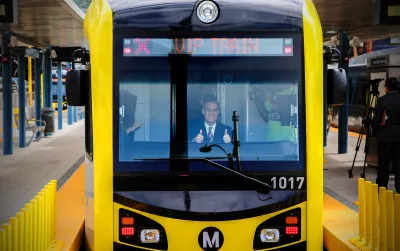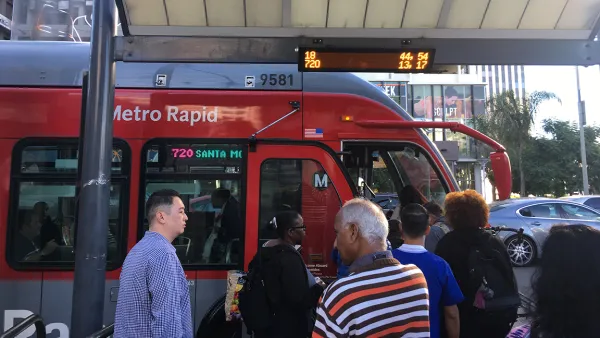Can Los Angeles convince drivers to cut the number of automobile trips in half while also transit frequency on several light rail lines?

Elijah Chiland reported at the end of April on an announcement of a "Green New Deal" by Los Angeles Mayor Eric Garcetti that sets a goal "to reduce the amount of driving in LA by nearly 50 percent in the next three decades."
Right now, LA drivers journey an average of 15 miles per capita per day, according to a report on the initiative released [in April]. That amounts to nearly 60 million miles driven per day within city limits.
Under Garcetti’s proposal, that would come down at least 13 percent by 2025 and 45 percent by 2050—a difference of more than 25 million miles each day, or 6.75 miles per person, should LA’s population stay relatively constant during that time.
Mayor Garcetti intends to achieve these ambitious goals by implementing safety improvements and streetscape projects already underway. Some experts are skeptical the city can achieve these goals, according to Chiland. "Juan Matute, deputy director of the UCLA Institute of Transportation Studies, tells Curbed the mayor’s goals are admirable—but won’t be easy to attain."
In Matute's own words: "Nothing that’s listed here will produce more than a 5 percent reduction […] It probably won’t bring them anything."
The actions of the regional transportation authority are already proving Matute's point about the difficulties of delivering on promises to cut driving. Since that announcement, the Los Angeles County Metropolitan Transportation Authority has decided to cut transit service on several of the region's light rail and high frequency bus lines, as reported in a much more recent article also by Chiland.
Metro’s Board of Directors [recently] approved a proposed $7.2 billion budget for the coming fiscal year, which begins in July. The financial plan includes a nearly 6 percent reduction in rail service hours, with the largest cuts planned on the Expo, Gold, and Blue lines. The change will result in fewer delays, according to Metro.
Chiland also notes that the board's action this week will also cut 75,000 hours of service from Metro's high frequency bus lines.
FULL STORY: Metro will scale back rail service, making for longer wait times

Analysis: Cybertruck Fatality Rate Far Exceeds That of Ford Pinto
The Tesla Cybertruck was recalled seven times last year.

National Parks Layoffs Will Cause Communities to Lose Billions
Thousands of essential park workers were laid off this week, just before the busy spring break season.

Retro-silient?: America’s First “Eco-burb,” The Woodlands Turns 50
A master-planned community north of Houston offers lessons on green infrastructure and resilient design, but falls short of its founder’s lofty affordability and walkability goals.

Test News Post 1
This is a summary

Analysis: Cybertruck Fatality Rate Far Exceeds That of Ford Pinto
The Tesla Cybertruck was recalled seven times last year.

Test News Headline 46
Test for the image on the front page.
Urban Design for Planners 1: Software Tools
This six-course series explores essential urban design concepts using open source software and equips planners with the tools they need to participate fully in the urban design process.
Planning for Universal Design
Learn the tools for implementing Universal Design in planning regulations.
EMC Planning Group, Inc.
Planetizen
Planetizen
Mpact (formerly Rail~Volution)
Great Falls Development Authority, Inc.
HUDs Office of Policy Development and Research
NYU Wagner Graduate School of Public Service




























